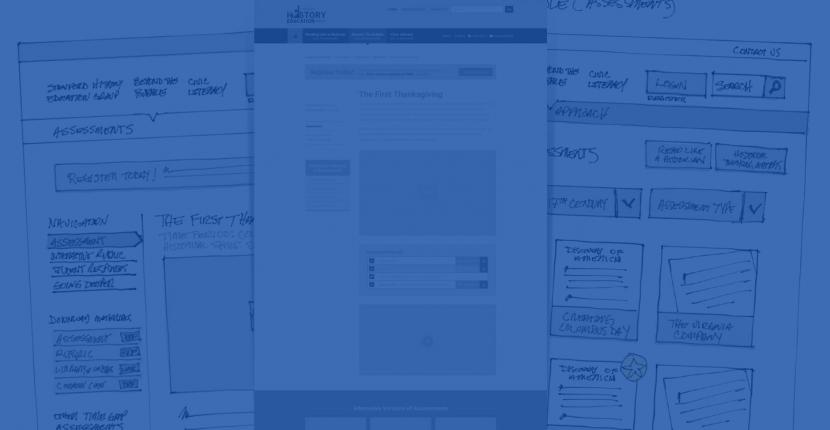Facebook. Twitter. Instagram. Pinterest. Mailing lists. Website. Blog. Comments. Calendar. Forums. Mobile. Web. Apps. Tablets. Phones. Content Strategy. Marketing Strategy. Experience Strategy. Brand Strategy. Web Analytics. Contextual Inquiry. Market research. Usability Testing. Interaction Design. Information Architecture. UI Design. SEO. Landing Page Design. User Experience. Creative Design...
And the list goes on.
There are a lot of different ways to look at how you want your users to interact with your brand online. Each with its own perspective and ideas on how you can spend your limited budget.
How do you choose the most appropriate tools for the task at hand? Maybe the more important question: do you fully understand the problem you are trying to solve?
At Bluespark, we’ve been taking a long hard look at how all these dots (social, web, mobile, etc.) connect and we realized something: it’s not enough to connect the different strategy and design dots. We need to provide a unified, strategic direction that each of these disciplines can use to orchestrate and focus their efforts.
Not only that, but this vision needs to be clear and needs to evolve in the face of a rapidly changing world.
No easy task.
The old way, not-the-same-as-the-new way.
You might think that a good Discovery process can answer solve this problem. There are a few issues that arise when you rely on Discovery for this, though.
First, each project has a separate Discovery process. So, if you have one project meant to improve your content strategy, another for your website, and yet another for your social media strategy, you’ll have three different Discovery meetings. Of course, all of these Discovery meetings are important — especially if you’re working with different vendors for each project. But, Discovery should be focused on clearly defining your expected project outcomes (meaning Key Results, which we’ll talk about below) rather than defining high level vision.
Which brings us to the second issue: Discovery sessions often mix in strategic definition when they should really be focused on defining tactics around a previously defined strategy. Most of the clients I have worked with (from AT&T to local non-profits) rarely have a clearly defined strategy.
This is a problem. Not only because you can easily end up with your social media plans at odds with your web plans at odds with your content strategy. At the very least, there may need to be a lot of re-work because of misunderstanding and miscommunications as each project moves from idea to code.
The new way, better-than-the-old way.
Our approach to this problem has evolved over the past year into what we’re calling Engagement Strategy.
There are several parts to Engagement Strategy, but at its core, it’s a high level look at your brand, channels, and audience—and how they interact with each other. To create our Engagement Strategy process, we’ve pieced together techniques and methodologies from some of the smartest minds around the world along with our own experience to create something that is core to the business process, measurable, and successful.
Understanding...
As with any great process, Engagement Strategy starts with understanding. You may, in fact, have many of these pieces in place today. What we want to do, though, is pull these things together so that we have a solid foundation of understanding to build our models and lay our plans.
...your brand
If you want to set a clear direction for your entire web presence, we need to first understand your organization.
The first thing we look at, with any Engagement Strategy, is your mission: What are you setting out to accomplish? We’re looking at a variety of things in your business including stakeholders, revenue centers, and, most importantly, we’re looking for your business mantra. That one succinct statement that explains why your organization exists can provide clear direction for everything the business does. Don’t worry, if you don’t have one, we’ll work with you to define it.
Read more: If you’re not familiar with Mantras, we suggest you watch this quick video from Guy Kawasaki explaining the concept.
One concept we want to experiment with, next time around, is actually creating a persona for the organization. Something that describes the personality of the organization—both how it exists today and how you’d like it to exist in the future.
...your platform
Your web platform consists of all the different ways you engage your audience online. For our purposes, we focus on your Web platform, but a broader scope could also include sales, customer service, and any other way physical way that you connect.
Your web platform can consist of any combination of social media (Facebook, Twitter, Instagram, Pinterest), websites (marketing site, landing pages, blog, comments, calendar, and forums), and across devices (mobile, web, apps, tablets).
It can be a lot. But it’s helpful to explore how you use each channel and, conversely, how your audience uses the channels to engage with your brand.
...your audience
Audience analysis examines your existing customer research (both demographic and ethnographic) and compares that to the understanding your key stakeholders hold. From these, we create a set of profiles and personae to represent these users. In addition to document the motivations, goals, and needs for each audience type, we also want to look at how each profile engages with your brand across the different channels we’ve identified.
Get Clarity: Successful Engagement
Once we have clarity on your business, audience, and platform, we can start to do some interesting modeling. This is where we start to get real clarity — clarity that we will use to set our Objectives that our different disciplines and organizations will use to drive their focus.
Relationship Model
If you have multiple audiences (and you probably do), we want to model how the different audiences relate to each other. In some cases, there may be a progression from one audience-type to another. In other cases, the different audiences may exist completely separate from each other.
The Relationship Model will reveal any connections between the audiences that we may have missed — particularly around which audience may have influence over other audiences.
Customer Journey Map
The Customer Journey map looks at the different interactions your customers have with your organization along different services or sales and marketing funnels. Typically, when we do these engagements, we focus on the top one or two customer types.
Engagement Model
After we have the Customer Journey, we evolve that into an Engagement Model.
Your Engagement Model takes the different customer touchpoints and creates an engagement funnel that shows how that customer will progressively increase their engagement with your brand across the different channels of your web platform.
We also identify Key Performance Indicators (KPIs) for each stage of the model. These KPIs indicates the health of that stage. If it’s down, it needs work. If it’s up, you keep doing what you’re doing.
Get Focused: Objectives and Key Results
What do we have so far?
We have an understanding of your audience, business, and platform. We also have a model for audience engagement across your different channels.
Now, we need to turn these insights into focus! This last step of the Engagement Strategy is to define Objectives for any projects and allow your project teams to define Key Results for your objectives.
Objectives are high level, ambitious goals. They are not measurable. But they do align everyone’s efforts around a single direction. Objectives can (and, really, should) be informed by all the work we’ve conducted to date — from the analysis of your business, audience, and platform to the clarification we’ve gained from our modeling.
You can set Objectives at a variety of levels within your organization. In other words, these do not need to come from the highest levels of your organization to be effective, but the higher up the chain they go, the more effective they will be.
Once your Objectives are defined, your project teams (Content Strategy, Marketing, Experience Strategy, development, etc.) will be responsible for setting measurable Key Results. Key Results are small, measurable improvements. They should be difficult to achieve, but not impossible. If you ever hit 100% of the KR, then you’re not setting your target high enough. By some estimates, the sweet spot of your Key Result should be 70-80% of your target.
Learn more: Intel pioneered Objectives and Key Results. Christina Wodtke has a great description of OKRs on her blog. Rick Klau presented the OKR concept to Google Startup Labs.
The End is the Beginning
The goal of this process is not to deliver a set of documents that you use once and throw away. In fact, the documentation delivered at the end is incomplete. It’s part of a whole that needs to be evolved and expanded over time. New objectives set. New audiences defined. Audience definitions refined as you learn more about them.
Ideally, you this process gives you clarity of your audience, business, and platform, which you use every quarter (or so) to define objectives and key results, which, in turn, leads to clarity around which features, content, and experiences your teams should focus.
We'd love to partner with you on your next project!
Since we’re big on relationships, we’re all about finding the right fit. Will you take the next step with us to see if we’re a match?




